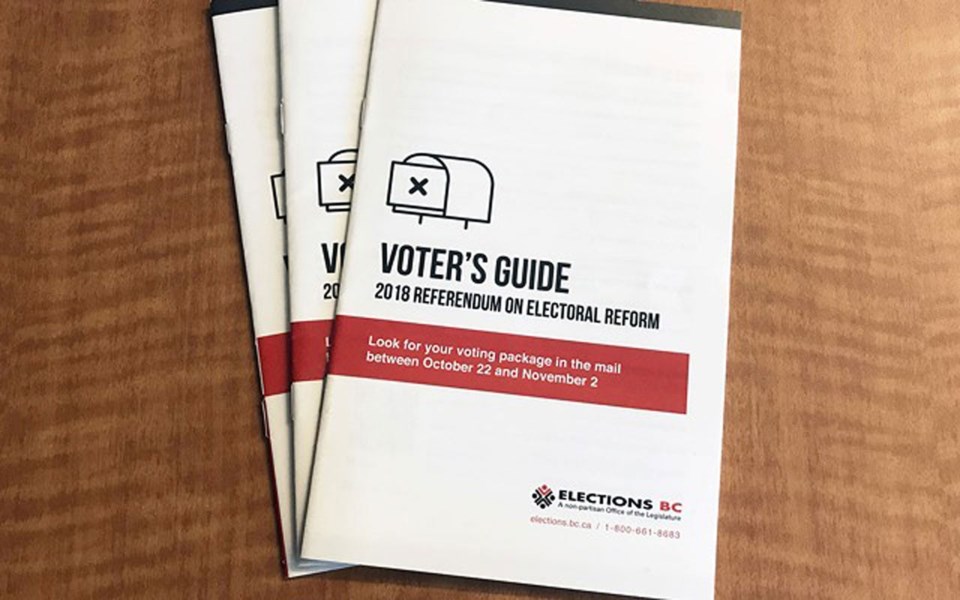The deadline to return your ballot on the First Past the Post versus Proportional Representation (PR) referendum has been extended to Dec. 7 by 4:30 pm. That means the ballot has to be at the counting office by that time—not post-office stamped.
So get your ballot form, sit down and let's figure it out.
Pique does not support political parties or candidates editorially, but what it does do is support democracy and encourages all voters, especially youth, to learn about our political machinery and take a position and vote.
In many ways voting in this ballot on the future of how we elect governments is more important for the young voter than anyone else.
For years, we have heard their refrain that they can vote but the person they vote for never gets elected.
We heard this after our last provincial election when the Green Party won three seats under the current voting regime. In a proportional representation (PR) system, the Greens likely would have had 15 people elected.
Yes, proportional representation can be messy, with coalitions the rule and not the exception, but as we look to other nations for guidance they are still managing to get things done. Indeed countries such as Germany, Norway, Sweden and Switzerland, which all have some form of proportional representation, have triple-A credit and bond ratings.
More than 80 democracies use some form of proportional representation; just under 60 use first-past-the-post, the current system which awards a seat to the candidate who gets the most votes.
In an analysis of electoral systems last year, the Fraser Institute found that 83 per cent of the elections held by governments with PR resulted in coalition governments.
So we know that Proportional Representation can work, just as we know that First Past the Post works—we have been living with it for decades—but which system most fairly represents the votes cast or results in the political leadership you want?
When you open your ballot form, you have three choices to choose from should you choose PR. They are:
• Dual Member Proportional (DMP): Most electoral districts are combined with a neighbouring district and represented by two Members of the Legislative Assembly (MLAs). One would be elected using FPTP. The second would be selected based on the province-wide vote to ensure all parties had representation that reflected their share of the vote.
• Mixed Member Proportional (MMP): where there are two types of MLAs. District MLAs represent electoral districts and are elected using First Past the Post. Regional MLAs represent groups of electoral districts called regions. They are elected from a party list so that each party's share of seats in the legislature roughly matches its share of the province-wide popular vote.
• Rural-Urban Proportional Representation: Urban ridings would elect up to seven MLAs using single-transferable vote. Under the system, voters rank as many candidates as they like and the results are based on their rankings (go to elections.bc.ca for more information on the choices).
Only one of these choices, MMP, is used by other nations. The other two options were designed with B.C. in mind. Attorney General David Eby led a four-month public consultation on proportional representation and the referendum and what became clear, Eby told the Tyee, was that the public wants an electoral system that is simple and produces proportional results, but not at the expense of local and rural representation.
British Columbia could see up to eight seats added under the three proportional representation systems. This issue is amongst the unknowns—including what new electoral boundaries would like—that would be decided after the referendum if voters opt for change.
Elections BC is busy counting all those ballots and if 50 per cent plus one choose Proportional Representation then it will tally up the votes for each of the three choices outlined above. If one of the three choices gets a majority then that will be used in the next election. If none of them get a majority the least popular system will be dropped and the next most-voted-for choice will rise to the top.
The government has said it will hold a referendum after two elections to see if voters are satisfied with how things are going or if they want to go back to First Past the Post.
So, you've thought about your choices, you've filled out the ballot, now go out and mail it.
One of the true measures of living in a democracy is that we have opportunities like this to make a difference in how we are governed. Don't let apathy or ignorance get in your way.




